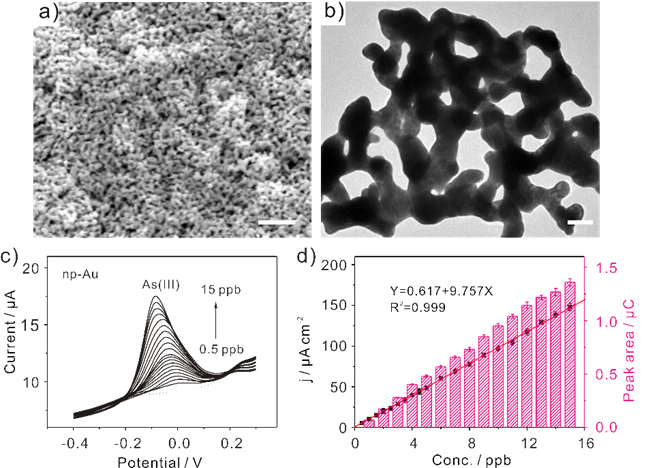Gold nanoparticles have good catalytic performance on the detection of arsenic(III) [As(III)]. However, most of the gold nanomaterials with different morphologies still need to be operated in strongly acidic media for the detection of As (III). In addition, the presence of other coexisting substances has a great interference. Therefore, how to obtain the effective detection of As(III) in mild conditions and improve its anti-interference performance is still necessary for further exploration.
Three-dimensional nanoporous materials are widely used in electricity, optics, catalysis, etc., due to its large specific surface area and special surface structure.
In general, the three-dimensional nanoporous gold (np-Au) prepared by the simple chemical etching method are easy to agglomerate but hard to obtain uniformly modified electrodes.
Recently, a study team led by Prof. HUANG Xingjiu and Prof. LIU Jinhuai in Institute of Intelligent Machines (IIM), Hefei Institutes of Physical Science, preliminarily explored the electrochemical analysis behavior toward As(III) with nanoporous gold. The research has been accepted for publication by Sensors and Actuators B: Chemical. (http://www.sciencedirect.com/science/journal/09254005)entitled “Enhanced anti-interference on electrochemical detection of arsenite with nanoporous gold in mild condition”.
In this work, researchers attempted to construct a np-Au modified electrode by chemical etching of AuCu bimetallic nanoparticles in situ firstly. And then, the electrochemical behavior of np-Au modified electrode for detection of As(III) was studied in mild condition (pH 5.0 acetate buffer solution). The results indicated that the etching of AuCu bimetallic nanoparticles in situ could obtain np-Au uniform modified electrode and np-Au modified electrode could be sensitive to As(III) in mild condition. Furthermore, np-Au modified electrode showed enhanced anti-interference performance while the np-Au modified GCE presented excellent sensing performance, which is attributed to its special surface structure, the fast transports of analytes and electron in the interface of electrode.
This work was supported by the National Basic Research Program of China (2011CB933700 and 2013CB934300), the National High Technology Research and Development Program of China (863 Program) (2013AA065602), the National Natural Science Foundation of China (21475133, 21377131, 61474122, 51202052,U1532123, 11405256 and U1532120).

Figure 1. a) and b) SEM and TEM images of the np-Au, respectively. c) Typical SWASV response of np-Au modified GCE for analysis of As(III). d) The corresponding plot of the analysis of As(III).
Article link: http://www.sciencedirect.com/science/article/pii/S0925400516306621
Title: Enhanced anti-interference on electrochemical detection of arsenite with nanoporous gold in mild condition
Key words: Nanoporous gold; Arsenite; Anti-interference; Mind condition
Contact:
Prof. HUANG Xing-Jiu, Ph. D Principal Investigator
Institute of Intelligent Machines, Chinese Academy of Sciences, Hefei 230031, China
Tel: 86-551-6559-1167
Email: xingjiuhuang@iim.ac.cn
